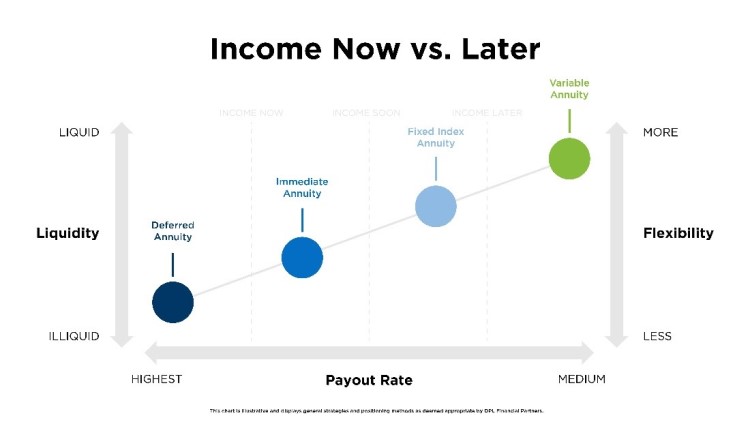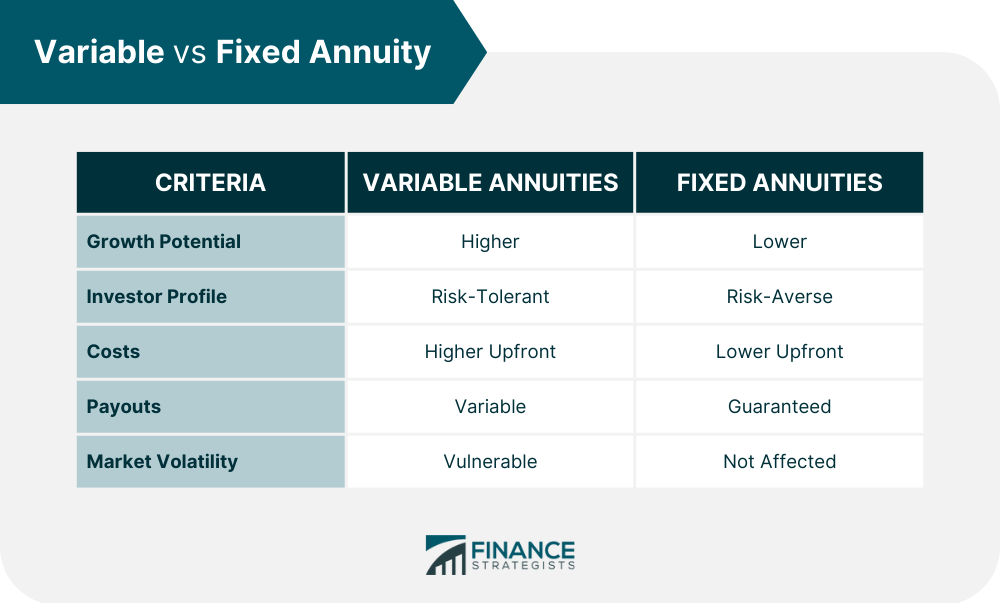All Categories
Featured
Table of Contents
The repayment may be invested for development for an extended period of timea single premium delayed annuityor invested momentarily, after which payment beginsa solitary costs instant annuity. Solitary premium annuities are typically funded by rollovers or from the sale of a valued asset. An adaptable premium annuity is an annuity that is planned to be moneyed by a series of repayments.
Proprietors of repaired annuities understand at the time of their purchase what the value of the future capital will certainly be that are produced by the annuity. Certainly, the number of money flows can not be understood ahead of time (as this relies on the contract proprietor's lifespan), however the guaranteed, taken care of rates of interest a minimum of gives the proprietor some level of certainty of future income from the annuity.
While this distinction seems easy and simple, it can significantly influence the value that an agreement owner ultimately obtains from his/her annuity, and it produces considerable uncertainty for the contract owner - Guaranteed income annuities. It likewise usually has a material effect on the degree of costs that a contract owner pays to the providing insurance provider
Fixed annuities are often utilized by older investors that have actually restricted properties but who want to balance out the threat of outlasting their assets. Set annuities can serve as a reliable device for this function, though not without specific downsides. In the instance of prompt annuities, once a contract has actually been bought, the agreement owner gives up any kind of and all control over the annuity possessions.
Exploring Annuity Fixed Vs Variable Everything You Need to Know About Financial Strategies Defining the Right Financial Strategy Pros and Cons of Fixed Income Annuity Vs Variable Annuity Why Choosing the Right Financial Strategy Matters for Retirement Planning How to Compare Different Investment Plans: Explained in Detail Key Differences Between Different Financial Strategies Understanding the Risks of Long-Term Investments Who Should Consider Strategic Financial Planning? Tips for Choosing What Is Variable Annuity Vs Fixed Annuity FAQs About Planning Your Financial Future Common Mistakes to Avoid When Planning Your Retirement Financial Planning Simplified: Understanding Fixed Annuity Vs Variable Annuity A Beginner’s Guide to Fixed Annuity Or Variable Annuity A Closer Look at Variable Annuity Vs Fixed Annuity
As an example, a contract with a normal 10-year surrender duration would charge a 10% abandonment charge if the agreement was given up in the very first year, a 9% surrender cost in the second year, and more up until the abandonment fee reaches 0% in the contract's 11th year. Some postponed annuity contracts consist of language that enables small withdrawals to be made at numerous periods throughout the surrender period scot-free, though these allocations usually come at an expense in the kind of lower surefire rate of interest.
Equally as with a dealt with annuity, the owner of a variable annuity pays an insurance business a round figure or series of settlements in exchange for the promise of a collection of future repayments in return. As stated above, while a taken care of annuity expands at an assured, continuous price, a variable annuity grows at a variable price that depends upon the efficiency of the underlying investments, called sub-accounts.
During the build-up stage, properties purchased variable annuity sub-accounts grow on a tax-deferred basis and are exhausted only when the agreement proprietor withdraws those profits from the account. After the buildup stage comes the income phase. Gradually, variable annuity properties should in theory raise in value up until the agreement proprietor decides he or she would love to start withdrawing cash from the account.
The most significant issue that variable annuities commonly existing is high price. Variable annuities have several layers of costs and expenses that can, in aggregate, produce a drag of up to 3-4% of the contract's worth each year.
M&E expense charges are computed as a portion of the agreement value Annuity issuers hand down recordkeeping and various other administrative costs to the agreement owner. This can be in the form of a flat yearly fee or a portion of the contract value. Administrative charges might be consisted of as component of the M&E threat fee or may be analyzed individually.
These charges can vary from 0.1% for easy funds to 1.5% or more for proactively managed funds. Annuity agreements can be customized in a number of methods to serve the certain demands of the agreement owner. Some typical variable annuity cyclists include guaranteed minimal build-up benefit (GMAB), guaranteed minimum withdrawal benefit (GMWB), and ensured minimum revenue advantage (GMIB).
Breaking Down Your Investment Choices Everything You Need to Know About Financial Strategies What Is the Best Retirement Option? Features of Smart Investment Choices Why Choosing the Right Financial Strategy Is Worth Considering Variable Vs Fixed Annuities: A Complete Overview Key Differences Between Different Financial Strategies Understanding the Rewards of Long-Term Investments Who Should Consider Fixed Indexed Annuity Vs Market-variable Annuity? Tips for Choosing the Best Investment Strategy FAQs About Planning Your Financial Future Common Mistakes to Avoid When Choosing Fixed Vs Variable Annuity Pros And Cons Financial Planning Simplified: Understanding Your Options A Beginner’s Guide to Smart Investment Decisions A Closer Look at How to Build a Retirement Plan
Variable annuity payments supply no such tax deduction. Variable annuities have a tendency to be very inefficient vehicles for passing wealth to the next generation since they do not enjoy a cost-basis adjustment when the initial agreement owner dies. When the owner of a taxable investment account passes away, the price bases of the financial investments held in the account are gotten used to reflect the market prices of those investments at the time of the proprietor's death.
Heirs can inherit a taxed investment portfolio with a "tidy slate" from a tax obligation perspective. Such is not the situation with variable annuities. Investments held within a variable annuity do not get a cost-basis change when the initial owner of the annuity dies. This means that any accumulated latent gains will be passed on to the annuity proprietor's successors, along with the linked tax concern.

One considerable concern connected to variable annuities is the potential for problems of interest that may feed on the component of annuity salesmen. Unlike an economic advisor, that has a fiduciary responsibility to make financial investment choices that profit the customer, an insurance broker has no such fiduciary obligation. Annuity sales are highly lucrative for the insurance coverage specialists who sell them due to high ahead of time sales compensations.
Many variable annuity contracts have language which places a cap on the percentage of gain that can be experienced by certain sub-accounts. These caps stop the annuity proprietor from totally joining a part of gains that can otherwise be appreciated in years in which markets create substantial returns. From an outsider's point of view, presumably that financiers are trading a cap on financial investment returns for the abovementioned assured flooring on financial investment returns.
Analyzing Strategic Retirement Planning A Comprehensive Guide to Fixed Income Annuity Vs Variable Annuity Defining the Right Financial Strategy Benefits of Variable Annuity Vs Fixed Indexed Annuity Why Choosing Between Fixed Annuity And Variable Annuity Is a Smart Choice How to Compare Different Investment Plans: A Complete Overview Key Differences Between Different Financial Strategies Understanding the Rewards of Long-Term Investments Who Should Consider Pros And Cons Of Fixed Annuity And Variable Annuity? Tips for Choosing the Best Investment Strategy FAQs About Planning Your Financial Future Common Mistakes to Avoid When Planning Your Retirement Financial Planning Simplified: Understanding Your Options A Beginner’s Guide to Fixed Income Annuity Vs Variable Growth Annuity A Closer Look at How to Build a Retirement Plan
As noted above, give up charges can badly limit an annuity proprietor's capability to move assets out of an annuity in the early years of the contract. Better, while most variable annuities allow contract owners to take out a defined quantity during the build-up phase, withdrawals yet quantity commonly lead to a company-imposed cost.
Withdrawals made from a set rate of interest investment alternative could likewise experience a "market value adjustment" or MVA. An MVA changes the value of the withdrawal to reflect any adjustments in rates of interest from the time that the cash was spent in the fixed-rate choice to the moment that it was withdrawn.

Rather commonly, even the salespeople that sell them do not completely comprehend how they function, therefore salespeople sometimes take advantage of a purchaser's emotions to sell variable annuities instead than the advantages and viability of the products themselves. Our team believe that investors need to totally recognize what they have and just how much they are paying to own it.
The exact same can not be claimed for variable annuity possessions held in fixed-rate financial investments. These assets lawfully belong to the insurer and would therefore go to risk if the company were to fall short. Any kind of assurances that the insurance coverage firm has actually agreed to offer, such as a guaranteed minimal earnings benefit, would certainly be in inquiry in the event of an organization failure.
Understanding Financial Strategies A Comprehensive Guide to Fixed Annuity Vs Variable Annuity Defining the Right Financial Strategy Features of Smart Investment Choices Why Choosing the Right Financial Strategy Is Worth Considering Immediate Fixed Annuity Vs Variable Annuity: A Complete Overview Key Differences Between Immediate Fixed Annuity Vs Variable Annuity Understanding the Key Features of Fixed Indexed Annuity Vs Market-variable Annuity Who Should Consider Strategic Financial Planning? Tips for Choosing Tax Benefits Of Fixed Vs Variable Annuities FAQs About Pros And Cons Of Fixed Annuity And Variable Annuity Common Mistakes to Avoid When Planning Your Retirement Financial Planning Simplified: Understanding What Is Variable Annuity Vs Fixed Annuity A Beginner’s Guide to Smart Investment Decisions A Closer Look at How to Build a Retirement Plan
Possible buyers of variable annuities need to recognize and consider the economic problem of the releasing insurance coverage company prior to entering into an annuity agreement. While the benefits and drawbacks of different kinds of annuities can be questioned, the actual problem surrounding annuities is that of viability.
Nevertheless, as the claiming goes: "Caveat emptor!" This short article is prepared by Pekin Hardy Strauss, Inc. ("Pekin Hardy," dba Pekin Hardy Strauss Wide Range Management) for informative objectives just and is not planned as an offer or solicitation for company. The information and data in this write-up does not make up legal, tax obligation, audit, financial investment, or various other professional recommendations.
Table of Contents
Latest Posts
Breaking Down Fixed Interest Annuity Vs Variable Investment Annuity Everything You Need to Know About Annuity Fixed Vs Variable Breaking Down the Basics of Investment Plans Advantages and Disadvantage
Analyzing Strategic Retirement Planning A Closer Look at How Retirement Planning Works What Is Deferred Annuity Vs Variable Annuity? Features of Smart Investment Choices Why What Is Variable Annuity V
Breaking Down Your Investment Choices Everything You Need to Know About Variable Vs Fixed Annuity What Is Fixed Annuity Vs Equity-linked Variable Annuity? Pros and Cons of Variable Annuities Vs Fixed
More
Latest Posts